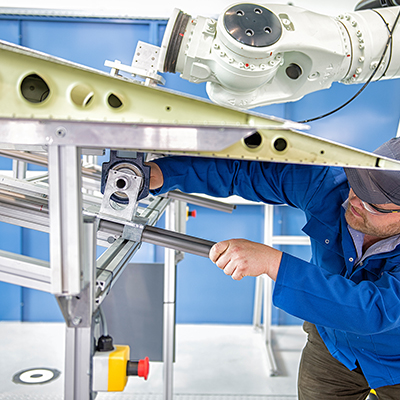Background
Smart structures can help to improve structural integrity, control vibrations and noise and provide capabilities for adaptive shape changing or shape 'morphing'. Their diverse applications range from space systems to aircraft structures, wind turbines and medical systems. Morphing structures following biologically inspired designs have an intelligent ability to optimise their shape in operation using distributed sensors and actuators. In nature, this adaptive ability has been observed in many species: for example, birds which mould the shape of their body and change the configuration of their wings in a complex way to adapt themselves to the current flight phase. The radical continuous aerodynamic shape changes attained by morphing technology can enhance flow control effectiveness locally and offer significant improvements for example to aircraft performance globally.
Technology overview
Requirements for morphing structures are conflicting as the structures must be stiff to withstand external loads, but flexible to enable shape changes. A solution enabled by the current technology is to design a structure such that the two actions are decoupled through using components with extreme anisotropy and integrated actuation, though without negatively impacting the weight, complexity and reliability of the parts.
Unconventional and novel material characteristics are required, which can be achieved based on a bio-inspired philosophy, where many levels of hierarchy in the multi-scale structural design are used to improve material performance and functionality. A novel mechanical metamaterial based on a 'fish cells' structure has been developed, capable of achieving zero Poisson’s ratio (ZPR) in two planar directions.
Benefits
- The problem of 'stiffness augmentation' in a structure, which resists a shape change under deformation, can be addressed by using the ZPR 'fish cells' metamaterial as a compliant 'skin' or cladding, as stress coupling will no longer exist. Furthermore the 'fish cells' metamaterial aims to remove stiffness augmentation under large deformations without undesired side effects on neighbouring components.
- Greater flexibility is enabled for a designer to create structures for applications where out-of-plane bending-twist is required for large spans, e.g. aircraft wings under flexure, due to extension-shear coupling, which is a very important advantage.
- Use for morphing applications is beneficial because, as well removing stiffness augmentation, anticlastic curvature is prevented, which provides better geometric conformability. Substituting ZPR metamaterials for conventional honeycombs can solve many structural integrity issues. Key benefits are minimising weight and maximising multi-functionality to reduce material demand and to increase resource efficiency.
Applications
Enabling smart changes in the shape of aircraft wings and engine structures in flight creates a range of challenges requiring radical technology development, and ZPR materials have benefits here. Applications of smart morphing structures are expected to enhance engine performance, reduce fuel consumption, decrease toxic emissions and reduce noise pollution.
There are potential applications in advanced wind turbines with superior performance, tidal turbines with increased resilience, medical implants and drug delivery systems with conformity and efficiency. Seismic resilient buildings and transport infrastructures can be designed through hierarchical metamaterials capable of self-adapting under extreme vibration to maximise the vibration damping and crashworthiness. There are further applications possible for sports equipment (including sportswear, sports protective devices and body armour, running shoes, textiles), automotive structures, components and construction products.
Opportunity
Cranfield University is seeking expressions of interest from industrial partners interested in using the design and simulation know-how and novel materials to develop new products or to collaborate in development.
Licensees and potential users of the technology are invited to get in touch.
IP status
UK (GB2578296A) and PCT (WO2020079424A) patent applications have been filed (with a priority date of 19 October 2018) for novel surface structures with applications for wing skins and other morphing structures.
Seeking
Licensing, collaborative development, consultancy.
Figures
Above: Figure 1 - A material for exhibiting zero Poisson's ratio (ZPR), e.g. for use as a morphing material in an aircraft skin. The material has a tessellated cellular structure where each cell has a substantial fish shape. Tessellations can be arranged in columns in the same direction or opposite directions, preferably with connectors therebetween.



